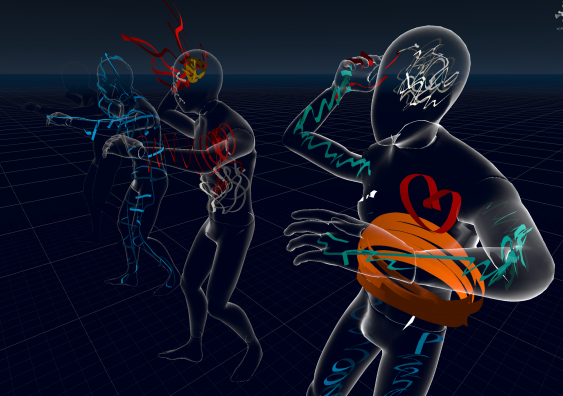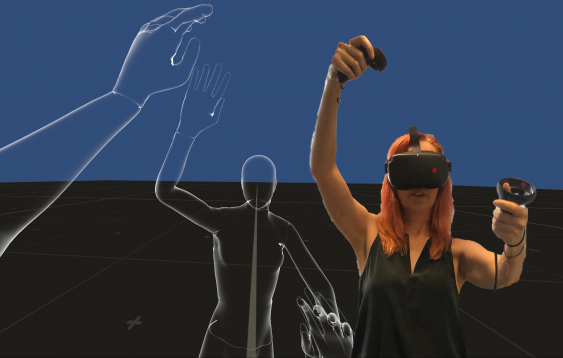Scientia Professor Jill Bennett says the arts offer useful ways of dealing with complex mental health and emotional challenges.

Body mapping session in Virtual Reality using EmbodiMap developed by UNSW fEEL Lab Scientia Professor Jill Bennett and lead immersive media designer Volker Kuchelmeister. Image: Dr Jill Bennett
People often think that prioritising art in a time of crisis is counterintuitive but ARC Laureate Fellow and UNSW Professor of Experimental Arts, Professor Jill Bennett says it’s very important.
“I think it’s exactly now that we need these kinds of tools,” she says. “One of the things that art does well – and has done for hundreds of years – is to investigate challenging human experiences. This opens up the potential for reflecting on and understanding our own and others mental states and feelings of distress and anxiety.”
Professor Bennett notes that evidence suggests that 65% or more of Australians with a mental health issue don’t seek help. That’s why she is advocating for work around mental health to also be done outside the health sector.
“We need to support people in more ways than just medically,” she says.
For Professor Bennett, who is also the founding Director of The Big Anxiety festival, art exists beyond the gallery or the museum – and creative mental health interventions take place in environments that people want to be in, and enjoy being in, rather than a medical space.
“The creative process is very different from, say, a course of cognitive behaviour therapy or something medicalised,” she says. Art doesn’t substitute for medical interventions, but it offers something else that is beneficial.
“Art can be a means of reflecting on and processing difficult emotions or complex mental states. It can help us gain perspective, insight and agency, as well as the capacity to communicate”.
On one level, that increased understanding can come through casual engagement with art or it can come through the form of larger art-based projects, Professor Bennett says. But in both cases, it’s like a form therapy insofar as it helps us develop agency and emotional awareness.
Professor Bennett has an ARC funded Lab called fEEL (felt Experience & Empathy Lab) where psychologists and art specialists work together developing techniques and practises that are beneficial in a whole range of mental health, trauma and anxiety contexts.

Body mapping session in Virtual Reality using EmbodiMap developed by UNSW fEEL Lab Scientia Professor Jill Bennett and lead immersive media designer Volker Kuchelmeister. Image: Dr Jill Bennett
Through fEEL she has recently developed EmbodiMap – a therapeutic body mapping tool that uses Virtual Reality to allow users to engage with and map their feelings, thoughts and emotions.
“We often feel anxiety in the body. You may feel a response in your throat or your gut, for example. Body mapping, which is used extensively by my colleague, Professor Katherine Boydell at Black Dog Institute, is a process of mapping those embodied feelings, by drawing. EmbodiMap allows us to do this in VR, interacting in a physical way with 3D body images.
“When you feel anxious it can be useful to think about what’s happening in your body. You need to notice the patterns of what’s happening, and develop a way of intervening when stress or anxiety occurs.”
She says that the EmbodiMap is a good illustration of this because it works with those processes. It gives people a potent way of visualising what’s happening to them by encouraging them to paint internal sensations as they are experienced onto a 3D facsimile of the body, which can also be posed and manipulated, thus creating an interactive tool to exert some control over anxious thoughts and feelings.
“That’s not to say you can instantly and mechanically make anxiety go away,” she says. “But having that sort of perspective and insight and being able to see much more clearly what’s going on, does give you a much greater degree of agency and insight. Those things we know are really critical when it comes to managing anxiety and emotional health.”
Professor Bennett’s team is looking for participants to be involved in the testing phase of EmbodiMap, which can be used in conjunction with body-focused therapies or as stand-alone activity.





